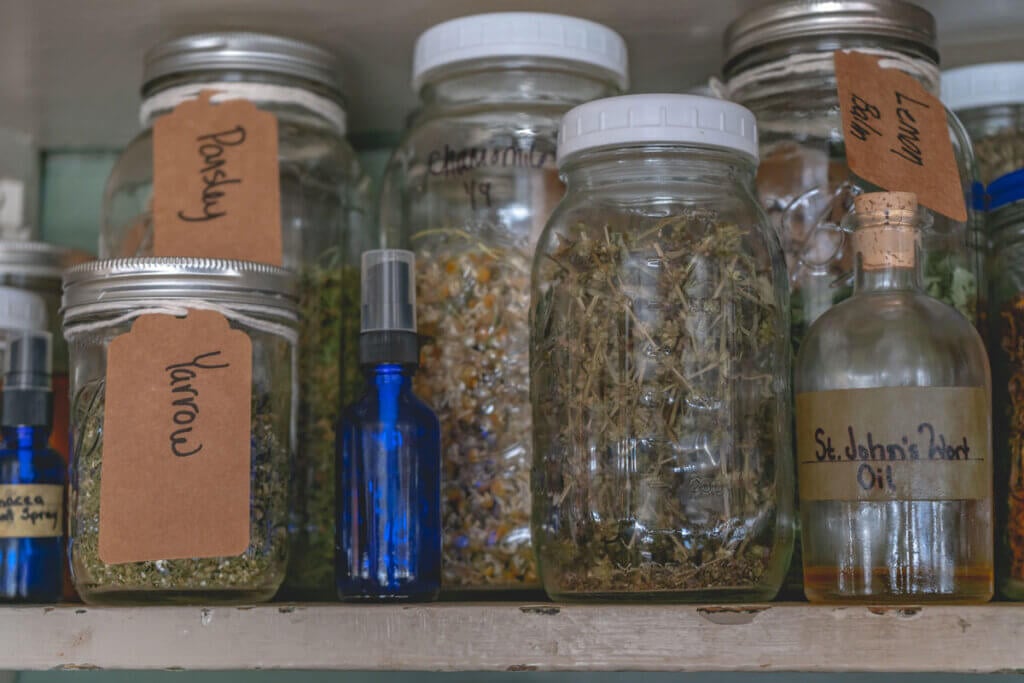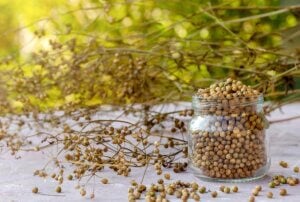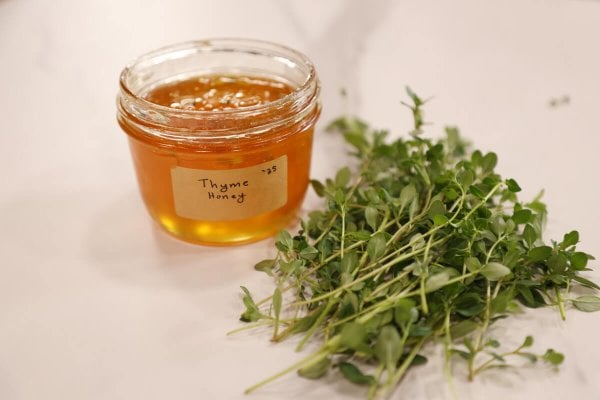
Chamomile is one of the oldest known herbs used by cultures worldwide. Dating back 5,000 years, it’s known as the “herb of the sun” by Egyptians and touted for its medicinal benefits by the ancient Roman and Greek cultures.

The benefits of growing chamomile go far beyond a good tea. It is commonly used to relax the nerves and bring about a restful sleep. (Source) Learn how to use this immune-building plant for skin, hair, and more—promoting health and healing qualities! (Source)
Why I Love Growing Chamomile
When learning how to use herb medicine safely at home, you will understand that you can’t just drink a couple of cups of chamomile tea right before bed and expect it to help you fall asleep. Many people try this approach and conclude that herbs aren’t effective.
However, when you study medicinal herbs and their uses and start using medicinal herbs as part of your wellness regimen to boost your immune system naturally, you will find that herbs are incredibly powerful in prevention and healing.
Chamomile is an herb I have grown in my old-fashioned cottage garden for years and is one of my top 15 medicinal herbs to grow. Chamomile is an easy to grow herb that can be used in various ways, providing numerous health benefits.
This guide can help you start your own herbal wellness journey by giving you the information you need to start growing, preserving, and using chamomile as a part of your regular regimen.
It’s important to note that I am not a certified medical practitioner. This post is not intended to diagnose or treat but is for informational purposes only. Please contact your medical care professional before introducing new herbal remedies into your wellness routine.

What Is Chamomile
There are two types of chamomile. Matricaria chamomilla, often called “German chamomile” or “Water of Youth.” And Chamaemelum nobile – (L.) All, often called Roman, English or garden chamomile. Chamomile is from the Asteraceae or Compositae family (milk thistle, echinacea) and grows easily along grassy roadways and fills pastures with its happy flower resembling the daisy, yet is often mistaken for a weed.
This prolific annual or perennial (depending on variety) plant grows worldwide from Britain to the Azore Islands. It is used by cultures around the world for its medicinal value, increasing good health and immunity.
Chamomile’s green leaves are tender, and the daisy-like flower arrives from June to the first frost, ripening and dropping chamomile seeds through October. This herb is a hermaphrodite making itself fertile. It attracts bees, flies and beetles for pollination.
- Roman Chamomile – This evergreen perennial is edible, and you can use the fresh or dried flower for teas, baths, and tinctures for stomach issues and gas.
- Golden Chamomile – This variety is a perennial and can be used in tea for stomach issues and gas. It soothes the skin when applied externally, and is often used in a warm bath.
- German Chamomile – This annual plant variety has a more bitter flavor than other varieties, making it suitable for teas and tinctures for stomach issues and to treat skin wounds. (Source)
- Spanish Chamomile – This perennial variety has a pungent root that stimulates the salivary glands, irritating the tissue and increasing the blood flow to the area. Toothaches and sore throats often benefit from the essential oil made from this variety. (Source)

Health Benefits of Chamomile
Chamomile’s sedative and nervine properties are best known as a nighttime hot tea to help relax the body and restore sleep. However, chamomile has many more health benefits than herbal tea before bed for relaxation and sleep.
Steeping medicinal teas is just one simple and inexpensive way to start with herbalism. Here are a few more ways to use the flowers and leaves of this fantastic herb.
Please Note: If you are allergic to ragweeds or are using blood thinners, it would be best to talk to your health care professional before using chamomile.
- Upset Stomach & Gas – Chamomile used in tincture form or as a warm tea helps soothe an upset stomach. Children can use this wonder herb safely and benefit from its healing properties.
- Conjunctivitis – Pink Eye is painful and contagious. Chamomile taken orally as a tincture with its healing qualities soothes and repairs this uncomfortable infection. (Source)
- Skin Conditions – You can soothe sunburns, scrapes and skin irritations with the antioxidant benefits naturally found in chamomile-laden lotions.
- Hydrates Skin – The compound levomenol found in German chamomile keeps your skin hydrated when used as a natural moisturizer. Levomenol helps diminish photo damage from excessive sun exposure. (Source)
- Sleep & Relaxation – Chamomile is most often used in tea (hot or cold) at the end of the day to bring a sense of calm and promote sleep.
- Hair – Chamomile tincture can be used in shampoo, rubbed gently into the scalp stimulating the hair follicles and bringing a sense of calm when inhaled.
- Fever Reducer – When a small amount of tincture is added to warm water and administered as an enema, Chamomile can help reduce a high fever.
- Immune Booster – Chamomile contains apigenin, which improves immune system function.

Ways to Prepare Chamomile
Chamomile may be considered a common herb, but the dry flowers’ anti-inflammatory, antispasmodic and stomachic properties are exceptional! Chamomile plants provide various uses, making them extraordinary and one I keep on hand in my herbal medicinal cabinet.
- Tea, Cold Brewed – After a long hot summer day of exertion, chamomile’s fresh flowers make a soothing instant herbal iced tea that brings a therapeutic element to a tired body.
- Tea, Hot Steeped – The soothing benefits of chamomile tea, helping you fall asleep and feel rested instead of groggy in the morning, are wonderful. We also enjoy making hops tea for some of the same medicinal benefits as chamomile tea.
- Tinctures – You can use dried chamomile to make an herbal tincture to help heal various ailments, from pink eye to skin rashes.
- Herb Capsules – When you make herbal capsules, you can stock up your medicinal cabinet with chamomile and much more.
- Shampoo – Adding chamomile tincture to shampoo soothes the scalp, and its lovely scent brings a sense of calm.
- Lotion – The antioxidants in chamomile oil help protect and soothe the skin while relieving irritated, dry skin. Homesteading Hack: Try using chamomile essential oil as facial oil in this recipe for DIY rose face wash.
- Bath Oil or Flowers – A few drops of chamomile essential oil or a cup of dried flower petals and leaves added to the bath soothes the skin and relaxes the body with its calming scent.

Growing Chamomile
Chamomile varieties grow best when planted in fertile, well-drained soil in your herb or vegetable garden. To build up the health of our soil and increase its ability to drain well, we make compost the easy way and amend our garden each year.
Chamomile enjoys full sun and is drought tolerant but may need partial shade if grown in a hot climate.
Chamomile grows one to two feet tall and is a great companion plant for basil, mint, and the lemon balm plant in the herb garden and tomatoes, onions, cabbages and potatoes in the vegetable garden.
This fragrant daisy-like flower with its yellow centers attracts pollinators, making it a good neighbor to other plants in the garden.
Planting
Chamomile is extremely easy to direct sow in the garden. Learn how to read seed packets and familiarize yourself with the varieties before planting. If you are new to shopping for seeds, learning the best seeds to grow in the garden is a good idea.
This beautiful plant proliferates with a wild daisy-like flower in sandy, loamy soil. It prefers a soil pH of 5.6-7.5 neutral range. Knowing how to test your soil pH can help find the proper pH level to grow healthy chamomile.
Direct sow chamomile in late spring when the danger of frost has passed. Living in a northern climate with a short growing season, we still direct sow our seeds, but if you want to start them indoors, be sure to do so about 4-6 weeks before the last frost, then pot up the seedlings before planting in the garden, ensuring a good healthy start.
When planting chamomile, allow room for growth by spacing the plants 8” to 12” apart. Chamomile prefers moist, not soggy soil and good air circulation.
Some varieties of chamomile plants can grow up to two feet tall and become top-heavy; support it with a stick and twine to keep it from falling over. Some varieties become ground cover like a carpet; management is key.
Growing
Chamomile is self-seeding, so it can become quite prolific. Managing this plant is important if you don’t want it to take over too much space in the garden. Snip seedlings to ground level and pull out new seedlings if needed.
Homesteading Hack: Sharing cuttings from your chamomile plant is a great way to get to know your neighbors when moving to a new area.
Chamomile is a plant that won’t survive a frost. Some varieties are perennial, and some are annuals, so check your seed packets for the type you want to grow.

Harvesting
Chamomile is a “cut and come again” herb making it easy to plant, grow and harvest.
Harvest chamomile flower heads with pruning shears mid-day when the flowers are fully open, and the dew has had a chance to fully dry. The plant will bloom until the first frost, providing many summer flowers.
Harvesting chamomile leaves can be done along the way, which will continue growing until the first frost. It’s important not to harvest more than one-third of the plant at a time. The stress could slow production, and the chamomile won’t produce at full strength.
Preserving
The best method for preserving chamomile is drying them in the same way you would dry any herb using a dehydrator, oven, laying them to dry in a warm area with good airflow, or hanging them to dry (if you’re harvesting more than just the tops of the flowers). Once fully dried, chamomile will last for up to a year in an airtight container stored away from direct sunlight.

Using Herbal Medicine
When considering growing an herb that benefits your garden and your health, chamomile is an excellent choice. Always do your own research to be sure that an herb is right for you. All herbs have the potential to interact with pharmaceutical drugs, and if you have existing medical conditions, it is advisable to check with your healthcare professional before taking a new herb.
If you are ready to learn more about double-duty herbs that can heal your family naturally, the Herbal Medicine Cabinet: Colds and Flu class is designed just for you.
In this masterclass, I have created a simple system that will allow you to confidently stock your herbal medicine cabinet using simple herbs to safely, naturally and effectively treat your family this cold and flu season.



















